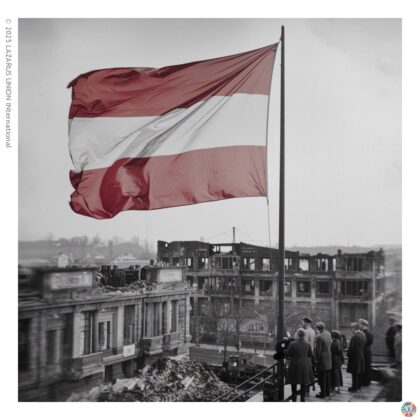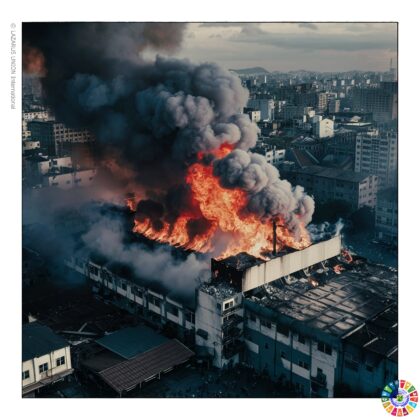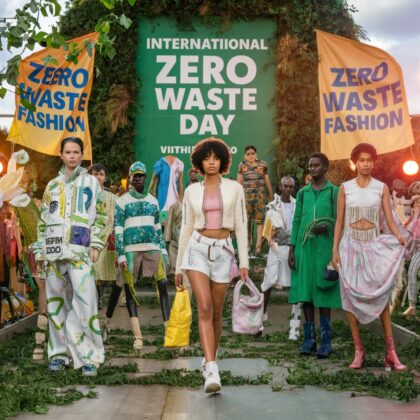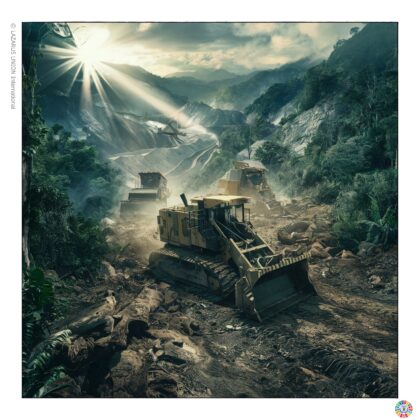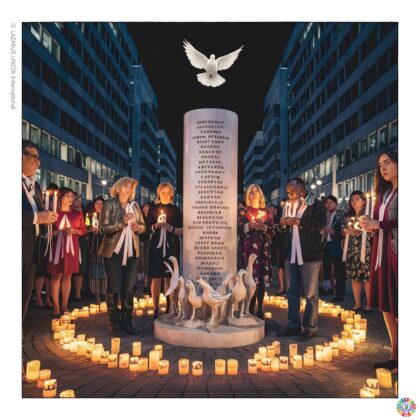On 27 April 1945, in the midst of the turmoil of the last days of the war, history was made in Vienna: With the proclamation of the Second Republic of... Read more

2024-04-13: The Rana Plaza Factory Collapse
A Tragic Reminder of Fast Fashion’s Hidden Cost
On April 24, 2013, one of the most devastating tragedies in the history of the global garment industry unfolded in Dhaka, Bangladesh. The collapse of the Rana Plaza factory claimed the lives of more than 1,100 workers and left thousands more injured. This tragic event not only drew global attention to the grim realities of labor exploitation within the fast fashion industry but also served as a stark reminder of the human cost behind the cheap clothing that floods our stores.
The Disaster: A Deadly Combination of Negligence and Greed
Rana Plaza was an eight-story building that housed several garment factories producing clothing for major global brands. The factory workers, predominantly women, were working under harsh conditions, long hours, and extremely low wages. But what most people didn’t know was that the building itself was in a dangerous state. The structure was not built to withstand the weight of the heavy machinery used in garment production, and numerous structural issues had already been identified. In the days leading up to the collapse, cracks had appeared in the walls, yet factory owners insisted that workers return to work the following day.
Despite the visible signs of danger, factory owners chose profits over people. They continued to pressure workers to work long hours, ignoring their safety concerns. On the morning of April 24, the building crumbled under the weight of the machinery, killing over 1,100 people and injuring thousands more. The victims of the collapse were not faceless individuals—they were people with families, dreams, and aspirations, all working in one of the world’s most dangerous industries in the hope of providing a better life for themselves.
The Dark Side of Fast Fashion
The workers in Rana Plaza were producing garments for some of the world’s most recognizable fast fashion brands, including Walmart, Benetton, Primark, and several others. These brands, which thrive on fast production cycles and low prices, were deeply embedded in the supply chain that allowed such tragedies to happen. Despite their connection to the factory, many of these brands initially failed to take responsibility for the unsafe working conditions that led to the disaster.
The Rana Plaza collapse laid bare the deadly consequences of the fast fashion industry’s insatiable demand for cheap labor. In the pursuit of lower production costs, global brands often turn to developing countries where labor laws are lax, and workers are paid a fraction of what they would be in more developed nations. This race to the bottom results in poor working conditions, exploitation, and—ultimately—tragic outcomes like the Rana Plaza disaster.
This tragedy highlighted how little oversight exists in the global supply chains of multinational corporations. While companies in developed countries demand low-cost goods, they often turn a blind eye to the working conditions in the factories that produce these goods. In many cases, the people who make our clothes are subjected to unsafe environments, long hours, and poverty wages, all in the name of maximizing profit margins.
Global Outrage and the Call for Change
The collapse of Rana Plaza sparked outrage worldwide. It was impossible to ignore the human cost of cheap fashion. Activists, labor rights groups, and concerned consumers began demanding that companies take responsibility for the conditions in their supply chains. This event catalyzed a movement calling for greater accountability from the fashion industry, urging companies to take a more active role in ensuring the safety and well-being of the people who make their clothes.
In the wake of the disaster, several labor rights organizations pushed for stronger regulations, improved working conditions, and compensation for the victims’ families. The Bangladesh Accord on Fire and Building Safety, signed by over 200 global apparel brands and retailers, was one of the positive outcomes. This agreement set guidelines for improving factory safety standards and worker protections in Bangladesh’s garment sector, ensuring that such a tragedy would not be repeated. However, the implementation of these reforms has been slow, and much work remains to be done to ensure the safety and dignity of workers in the garment industry worldwide.
A Turning Point in the Conversation about Ethical Fashion
The Rana Plaza disaster was a pivotal moment in the global conversation about the ethics of fast fashion. For years, consumers had unknowingly supported an industry that prioritized speed and profit over the well-being of its workers. But the tragedy of Rana Plaza forced many to rethink their purchasing habits and consider the true cost of cheap clothing. More and more people began questioning the practices of fast fashion brands and calling for greater transparency in the supply chain.
The disaster also led to a growing movement toward ethical and sustainable fashion. Consumers, activists, and brands alike began to recognize the importance of fair wages, safe working conditions, and environmental sustainability in the fashion industry. While many large brands have made some progress in improving labor practices, the Rana Plaza collapse reminded the world that the industry still has a long way to go before workers’ rights and safety are fully respected.
Moving Forward: The Need for Accountability and Change
The Rana Plaza collapse serves as a grim reminder of the consequences of unchecked greed and corporate negligence. It exposed the exploitation and suffering faced by millions of garment workers around the world and highlighted the urgent need for reform within the fast fashion industry. While the incident led to some positive changes, including improved safety standards in Bangladesh, the overall exploitation of garment workers continues.
To prevent further tragedies, it is essential that multinational corporations take full responsibility for the working conditions in their supply chains. Governments must also enforce stricter labor laws and ensure that workers’ rights are upheld. Moreover, consumers must continue to support ethical and sustainable fashion brands, demanding transparency and accountability from companies that profit from the labor of vulnerable workers.
In the years following the Rana Plaza disaster, the fashion industry has faced increasing pressure to become more ethical, and many brands have made commitments to improve their labor practices. However, the battle is far from over. The lesson of Rana Plaza is clear: the cost of cheap fashion is far too high, and it’s time for the industry to prioritize people over profit. By continuing to raise awareness, push for corporate accountability, and make more sustainable fashion choices, we can ensure that the tragedy of Rana Plaza is not forgotten, and that the rights and safety of garment workers are no longer sacrificed in the name of fast fashion.
Conclusion
The collapse of the Rana Plaza factory in 2013 was a wake-up call for the global fashion industry. It exposed the hidden cost of cheap clothing and ignited a global conversation about workers’ rights, safety, and ethics in the garment sector. While some progress has been made, much work remains to be done to ensure that tragedies like Rana Plaza never happen again. By supporting ethical fashion brands and demanding accountability from the companies that produce our clothes, we can work towards a future where garment workers are treated with the dignity and respect they deserve.




